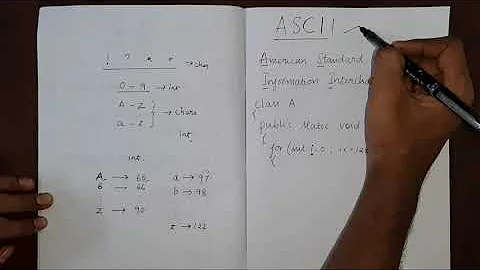How do I check if a string is unicode or ascii?
Solution 1
In Python 3, all strings are sequences of Unicode characters. There is a bytes type that holds raw bytes.
In Python 2, a string may be of type str or of type unicode. You can tell which using code something like this:
def whatisthis(s):
if isinstance(s, str):
print "ordinary string"
elif isinstance(s, unicode):
print "unicode string"
else:
print "not a string"
This does not distinguish "Unicode or ASCII"; it only distinguishes Python types. A Unicode string may consist of purely characters in the ASCII range, and a bytestring may contain ASCII, encoded Unicode, or even non-textual data.
Solution 2
How to tell if an object is a unicode string or a byte string
You can use type or isinstance.
In Python 2:
>>> type(u'abc') # Python 2 unicode string literal
<type 'unicode'>
>>> type('abc') # Python 2 byte string literal
<type 'str'>
In Python 2, str is just a sequence of bytes. Python doesn't know what
its encoding is. The unicode type is the safer way to store text.
If you want to understand this more, I recommend http://farmdev.com/talks/unicode/.
In Python 3:
>>> type('abc') # Python 3 unicode string literal
<class 'str'>
>>> type(b'abc') # Python 3 byte string literal
<class 'bytes'>
In Python 3, str is like Python 2's unicode, and is used to
store text. What was called str in Python 2 is called bytes in Python 3.
How to tell if a byte string is valid utf-8 or ascii
You can call decode. If it raises a UnicodeDecodeError exception, it wasn't valid.
>>> u_umlaut = b'\xc3\x9c' # UTF-8 representation of the letter 'Ü'
>>> u_umlaut.decode('utf-8')
u'\xdc'
>>> u_umlaut.decode('ascii')
Traceback (most recent call last):
File "<stdin>", line 1, in <module>
UnicodeDecodeError: 'ascii' codec can't decode byte 0xc3 in position 0: ordinal not in range(128)
Solution 3
In python 3.x all strings are sequences of Unicode characters. and doing the isinstance check for str (which means unicode string by default) should suffice.
isinstance(x, str)
With regards to python 2.x, Most people seem to be using an if statement that has two checks. one for str and one for unicode.
If you want to check if you have a 'string-like' object all with one statement though, you can do the following:
isinstance(x, basestring)
Solution 4
Unicode is not an encoding - to quote Kumar McMillan:
If ASCII, UTF-8, and other byte strings are "text" ...
...then Unicode is "text-ness";
it is the abstract form of text
Have a read of McMillan's Unicode In Python, Completely Demystified talk from PyCon 2008, it explains things a lot better than most of the related answers on Stack Overflow.
Solution 5
If your code needs to be compatible with both Python 2 and Python 3, you can't directly use things like isinstance(s,bytes) or isinstance(s,unicode) without wrapping them in either try/except or a python version test, because bytes is undefined in Python 2 and unicode is undefined in Python 3.
There are some ugly workarounds. An extremely ugly one is to compare the name of the type, instead of comparing the type itself. Here's an example:
# convert bytes (python 3) or unicode (python 2) to str
if str(type(s)) == "<class 'bytes'>":
# only possible in Python 3
s = s.decode('ascii') # or s = str(s)[2:-1]
elif str(type(s)) == "<type 'unicode'>":
# only possible in Python 2
s = str(s)
An arguably slightly less ugly workaround is to check the Python version number, e.g.:
if sys.version_info >= (3,0,0):
# for Python 3
if isinstance(s, bytes):
s = s.decode('ascii') # or s = str(s)[2:-1]
else:
# for Python 2
if isinstance(s, unicode):
s = str(s)
Those are both unpythonic, and most of the time there's probably a better way.
Related videos on Youtube
TIMEX
Updated on April 08, 2021Comments
-
TIMEX about 3 years
What do I have to do in Python to figure out which encoding a string has?
-
ulidtko about 13 yearsUnicode is not an encoding.
-
 alex over 5 years@Johnsyweb Because of
alex over 5 years@Johnsyweb Because of{UnicodeDecodeError} 'ascii' codec can't decode byte 0xc2
-
-
Ian Clelland over 11 yearsThe better way is probably to use
six, and test againstsix.binary_typeandsix.text_type -
user222758 over 10 yearsYou can use type(s).__name__ to probe type names.
-
 PythonNut about 10 yearsThis is false. In Python 2.7
PythonNut about 10 yearsThis is false. In Python 2.7isinstance(u"x",basestring)returnsTrue. -
KQ. about 10 years@PythonNut: I believe that was the point. The use of isinstance(x, basestring) suffices to replace the distinct dual tests above.
-
 PythonNut about 10 yearsNo, but
PythonNut about 10 yearsNo, butisinstance(x, basestring)is True for both unicode and regular strings, making the test useless. -
oligofren almost 10 yearsI am not quite sure of the use case for that bit of code, unless there is a logic error. I think there should be a "not" in the python 2 code. Otherwise you are converting everything to unicode strings for Python 3 and the opposite for Python 2!
-
 mhsmith about 9 yearsIt's useful in many cases, but evidently not what the questioner meant.
mhsmith about 9 yearsIt's useful in many cases, but evidently not what the questioner meant. -
fiatjaf about 9 yearsThis is the answer to the question. All others misunderstood what OP said and gave generic answers about type checking in Python.
-
Shadow over 7 yearsJust for other people's reference - str.decode doesn't not exist in python 3. Looks like you have to
unicode(s, "ascii")or something -
Dave Burton over 7 yearsYes, oligofren, that's what it does. The standard internal strings are Unicode in Python 3 and ASCII in Python 2. So the code snippets convert text to standard internal string type (be it Unicode or ASCII).
-
karantan over 7 yearsit should be
if isinstance(obj, six.text_type). But yes this is imo the correct answer. -
Shadow over 7 yearsSorry, I meant
str(s, "ascii") -
 MD004 about 6 yearsDoesn't answer OP's question. The title of the question (alone) COULD be interpreted such that this answer is correct. However, OP specifically says "figure out which" in the question's description, and this answer does not address that.
MD004 about 6 yearsDoesn't answer OP's question. The title of the question (alone) COULD be interpreted such that this answer is correct. However, OP specifically says "figure out which" in the question's description, and this answer does not address that. -
 MD004 about 6 yearsDoesn't answer OP's question. The title of the question (alone) COULD be interpreted such that this answer is correct. However, OP specifically says "figure out which" in the question's description, and this answer does not address that.
MD004 about 6 yearsDoesn't answer OP's question. The title of the question (alone) COULD be interpreted such that this answer is correct. However, OP specifically says "figure out which" in the question's description, and this answer does not address that. -
Jonny over 5 yearsThose slides are probably the best introduction to Unicode I've come across to date
-
Greg Hewgill about 5 years@ProsperousHeart: You're probably using Python 3.
-
 ProsperousHeart about 5 yearsThis is not accurate for python 3
ProsperousHeart about 5 yearsThis is not accurate for python 3 -
winbina about 5 years@ProsperousHeart Updated to cover Python 3. And to try to explain the difference between bytestrings and unicode strings.
-
Mansour.M over 4 yearsYou my friend deserve to be the correct response! I am using python 3 and I was still having problems until I found this treasure!
-
 RicarHincapie over 3 yearsdecode() method's default is 'utf-8'. So, if you call this method over a class 'bytes', you would get a 'OK' with
RicarHincapie over 3 yearsdecode() method's default is 'utf-8'. So, if you call this method over a class 'bytes', you would get a 'OK' withprint("utf8 content:", html.decode()), for example. -
 Edward Falk over 2 yearsNote: first, you need to confirm you're running Python2. If your code is designed to run under either Python2 or Python3, you'll need to check your Python version first.
Edward Falk over 2 yearsNote: first, you need to confirm you're running Python2. If your code is designed to run under either Python2 or Python3, you'll need to check your Python version first.






